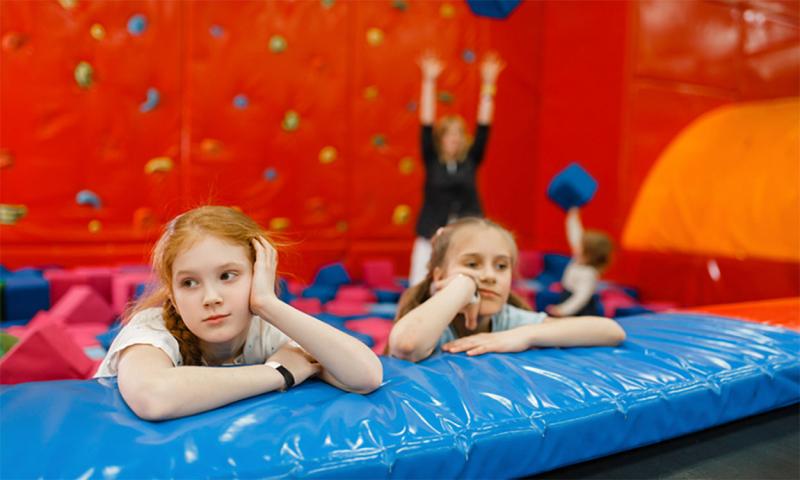Written by Emily Kranz, former SDSU Extension Health and Physical Activity Field Specialist
How much physical activity does my child need?
Physical activity plays a crucial role in development for children and teens. Regular physical activity strengthens muscles and bones, improves cardiovascular health, boosts mood, and improves cognitive function. According to the 2018 Physical Activity Guidelines for Americans, children and adolescents ages 6 to 17 should be physically active for at least 60 minutes every day. Playing, running, and jumping are an essential part of children’s physical growth and lay the foundation for future healthy physical development. All physical activity does not need to be accumulated at once; small chunks throughout the day can be combined to reach the 60-minute daily goal. Children should be moving at least a little bit every hour they are awake.
How much physical activity is too much?
There may be children and teens who are involved in an abundance of physical activities or sports teams. Some parents may be worried that their children are doing too much and that their bodies cannot handle the constant high activity level. It is important to remember that every child is different, and while some can handle intensive, year-round activities, others thrive on a more-relaxed approach, so being aware of the symptoms of overload and talking regularly with your child about their mental and physical wellbeing is important.

Children and teens can build up endurance similar to adults, but this should be done over time, progressively increasing activity. For example, if you want to train with your child to run a 5K race, you shouldn’t start out on Day 1 by running 3.1 miles; you slowly build-up over several weeks and months to add a little more distance or time each week until you reach your goal.
Signs of burnout in children and teens
- Persistent fatigue.
- Frequent injuries, even minor ones.
- Decreased performance.
- Changes in appetite and sleep habits.
- Loss of motivation.
- Irritability and mood changes.
- Negative self-talk or a focus on perfectionism.
Should my children specialize in one sport to limit exposure risk?
Parents may feel that they are limiting risk exposure if their child specializes in one single sport or activity, or that their children may excel if they only focus on one thing. Actually, sport specialization, especially at a young age, can lead to an increase in potential issues including:
- Increased risk for mental burnout.
- Increased injury risk and overuse injuries due to the repetitive nature of many sport skills, which can cause strains and micro-traumas on developing muscles, tendons, ligaments, and bones.
- Limited social interactions outside of their given activity.
Tips for child physical activity success and recovery

- Build in a minimum of 1 to 2 days per week where organized sport participation is limited to allow for adequate recovery and to avoid burnout. These days can be used for more-casual physical activity participation and rest. Downtime for rest is essential for both mental and physical recovery.
- Teach your children to listen to their body for when they are pushing themselves too far. Additionally, if a sport or activity is no longer brining your child regular joy from participating, it may be time to take a break or find an alternative option that sparks new enjoyment. Focus on enjoyment over accolades.
- Encourage variety, by participating in a number of different of activities throughout the year, which helps to develop different muscle groups and skills.
- Ensure that children are staying properly hydrated prior to, during, and after bouts of physical activity. Water should be the primary hydration beverage, but an electrolyte replacement beverage (such as Gatorade) may be appropriate for excessive physical activity or when in hot and humid climates.
- Proper nutrition with nutrient-dense foods is essential to fuel and repair the body, especially when staying very active. For busy sport tournament days, plan ahead and pack protein-dense foods and healthy snack options instead of relying on concession stand foods for refueling.
- Adequate sleep is essential for young, growing bodies, and is especially important for bodily repair. To accommodate late night practices or early morning travel to tournaments, even older children or teens may need to use naps or have earlier bedtimes other nights of the week to catch up on sleep. Practicing good sleep hygiene, like creating a calming, cool, dark sleep environment and limiting screentime before bed can also help maximize effective sleep.
Finding a Healthy Balance

Physical activity is an essential part of development, and starting at a young age lays the foundation for lifelong participation. Parents are great role models by modeling regular physical activity participation themselves. Encourage variety as your child explores new options to stay active and keep open lines of communication and watch for potential signs of burnout from your child.
References
- Jayanthi NA, Post EG, Laury TC, Fabricant PD. Health Consequences of Youth Sport Specialization. J Athl Train. 2019.
- Wilczyńska D, Qi W, Jaenes JC, Alarcón D, Arenilla MJ, Lipowski M. Burnout and Mental Interventions among Youth Athletes: A Systematic Review and Meta-Analysis of the Studies. Int J Environ Res Public Health. 2022.


